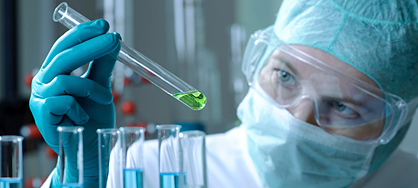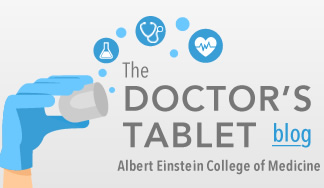
Parkinson's Disease Research
Scientists Identify 'Clean-Up' Snafu that Kills Brain Cells in Parkinson's Disease
March 3, 2013— (Bronx, NY) — Researchers at Albert Einstein College of Medicine of Yeshiva University have discovered how the most common genetic mutations in familial Parkinson's disease damage brain cells. The study, which published online today in the journal Nature Neuroscience, could also open up treatment possibilities for both familial Parkinson's and the more common form of Parkinson's that is not inherited.
Parkinson's disease is a gradually progressing disorder of the nervous system that causes stiffness or slowing of movement. According to the Parkinson's Disease Foundation, as many as one million Americans are living with the disease.
The most common mutations responsible for the familial form of Parkinson's disease affect a gene called leucine-rich repeat kinase-2 (LRRK2). The mutations cause the LRRK2 gene to code for abnormal versions of the LRRK2 protein. But it hasn't been clear how LRRK2 mutations lead to the defining microscopic sign of Parkinson's: the formation of abnormal protein aggregates inside dopamine-producing nerve cells of the brain.
"Our study found that abnormal forms of LRRK2 protein disrupt an important garbage-disposal process in cells that normally digests and recycles unwanted proteins including one called alpha-synuclein – the main component of those protein aggregates that gunk up nerve cells in Parkinson's patients," said study leader Ana Maria Cuervo, M.D., Ph.D., professor of developmental and molecular biology, of anatomy and structural biology, and of medicine and the Robert and Renée Belfer Chair for the Study of Neurodegenerative Diseases at Einstein.
The name for the disrupted disposal process is chaperone-mediated autophagy (the word "autophagy" literally means "self-eating"). It involves specialized molecules that "guide" old and damaged proteins to enzyme-filled structures called lysosomes; there the proteins are digested into amino acids, which are then recycled within the cell.
"We're now looking at ways to enhance the activity of this recycling system to see if we can prevent or delay neuronal death and disease."
– Ana Maria Cuervo, M.D., Ph.D.
"We showed that when LRRK2 inhibits chaperone-mediated autophagy, alpha-synuclein doesn't get broken down and instead accumulates to toxic levels in nerve cells," said Dr. Cuervo.
The study involved mouse neurons in tissue culture from four different animal models, neurons from the brains of patients with Parkinson's with LRRK2 mutations, and neurons derived from the skin cells of Parkinson's patients via induced pluripotent stem (iPS) cell technology. All the lines of research confirmed the researchers' discovery.
"We're now looking at ways to enhance the activity of this recycling system to see if we can prevent or delay neuronal death and disease," said Dr. Cuervo. "We've started to analyze some chemical compounds that look very promising."
Dr. Cuervo hopes that such treatments could help patients with familial as well as nonfamilial Parkinson's – the predominant form of the disease that also involves the buildup of alpha-synuclein.
Dr. Cuervo is credited with discovering chaperone-mediated autophagy. She has published extensively on autophagy and its role in numerous diseases, such as cancer and Huntington's disease, and its role in age-related conditions, including organ decline and weakened immunity. Dr. Cuervo is co-director of Einstein's Institute for Aging Research.
The paper is titled "Interplay of LRRK2 with chaperone-mediated autophagy." In addition to Dr. Cuervo, other Einstein contributors include Samantha J. Orenstein, a graduate student who performed most of this study as part of her Ph.D. thesis; Inmaculada Tasset, Ph.D.; Esperanza Arias, Ph.D.; and Hiroshi Koga, Ph.D., all members of Dr. Cuervo's group. Additional co-authors are: Sheng-Hang Kuo Ph.D., David Sulzer Ph.D., Etty Cortes, M.D., and Lawrence S. Honig, M.D. (Columbia University Medical School, New York, NY); William Dauer, M.D., (University of Michigan, Ann Arbor, MI); Irene Fernandez-Carasa and Antonella Consiglio, Ph.D., (University of Barcelona, Barcelona Spain); and Angel Raya, M.D., Ph.D., (Institucio Catalana de Recerca I Estudies Avancas, Barcelona, Spain).
This work was supported by grants from the National Institute on Aging (AG031782 and AG08702) and the National Institute of Neurological Disorders (NS038370) and Stroke Morris K. Udall Centers of Excellence, both part of the National Institutes of Health; The Rainwaters Foundation; The Beatrice and Roy Backus Foundation; JPB Foundation; Parkinson's Disease Foundation; Fondazione Guido Berlucchi; Centers for Networked Biomedical Research; and Ministry of Economy and Competitiveness; a Hirschl/Weill-Caulier Career Scientist Award; and a gift from Robert and Renée Belfer.
Other Top Stories
9/11 World Trade Center Exposure Linked to Heart Disease Among NYC Firefighters
On Becoming a Physician: New Einstein Students Receive White Coats and Stethoscopes
Novel Therapy for Acute Migraine Shows Promise in Phase 3 Clinical Trial
First Complete Wiring Diagram of an Animal's Nervous System
Multimillion Dollar NIH Grant to Help Reduce Opioid Use & Get Care to People Who Need It
NIH Grant Funds $23 Million Study of Diseases Affecting People Living with HIV
New TAILORx Data Guides Adjuvant Therapy in Younger Breast Cancer Patients
Einstein Celebrates Its 61st Commencement
Bolstering Biopsies: Testing Patients' Individual Cells to Guide Treatment



